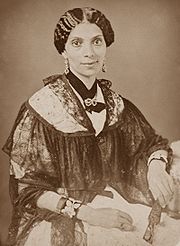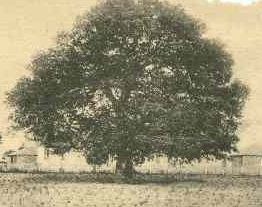
Mary S. Peake
Encyclopedia

United States
The United States of America is a federal constitutional republic comprising fifty states and a federal district...
teacher
Teacher
A teacher or schoolteacher is a person who provides education for pupils and students . The role of teacher is often formal and ongoing, carried out at a school or other place of formal education. In many countries, a person who wishes to become a teacher must first obtain specified professional...
and humanitarian, best known for starting a school for the children of former slaves starting in the fall of 1861 under what became known as the Emancipation Oak
Emancipation Oak
Emancipation Oak is a historic tree located on the campus of Hampton University in what is now the City of Hampton, Virginia. The large sprawling oak is 98 feet in diameter, with branches which extend upward as well as laterally...
tree in present-day Hampton
Hampton
-In Australia:*Hampton, Queensland*Hampton, Victoria*Hampton East, Victoria*Hampton Island*Hampton Park, Victoria-In Canada:*Hampton, New Brunswick*Hampton, Nova Scotia*Hampton, Ontario*Hampton, Prince Edward Island-In the United Kingdom:...
near Fort Monroe
Fort Monroe
Fort Monroe was a military installation in Hampton, Virginia—at Old Point Comfort, the southern tip of the Virginia Peninsula...
. The first Creole
Creole
- Languages :A Creole language is a stable, full-fledged language that originated from a pidgin or combination of other languages.Creole languages subgroups may include:* Arabic-based creole languages* Dutch-based creole languages...
teacher hired by the American Missionary Association
American Missionary Association
The American Missionary Association was a Protestant-based abolitionist group founded on September 3, 1846 in Albany, New York. The main purpose of this organization was to abolish slavery, to educate African Americans, to promote racial equality, and to promote Christian values...
, she was associated with its later founding of Hampton University
Hampton University
Hampton University is a historically black university located in Hampton, Virginia, United States. It was founded by black and white leaders of the American Missionary Association after the American Civil War to provide education to freedmen.-History:...
in 1868.
Early life and education
Mary Smith Kelsey was born free in Norfolk, VirginiaNorfolk, Virginia
Norfolk is an independent city in the Commonwealth of Virginia in the United States. With a population of 242,803 as of the 2010 Census, it is Virginia's second-largest city behind neighboring Virginia Beach....
. Her father was an Englishman "of rank and culture" and her mother was a free woman of color
Free people of color
A free person of color in the context of the history of slavery in the Americas, is a person of full or partial African descent who was not enslaved...
, described as light skinned. When Mary was six, her mother sent her to Alexandria
Alexandria County, D.C.
Alexandria County was part of the original 100-mile square created as the District of Columbia in 1791 pursuant to Article I, Section 8, paragraph 17, of the United States Constitution...
(then part of the District of Columbia) to attend school. Living with her aunt Mary Paine, Kelsey studied for about ten years. The US Congress enacted a law prohibiting free people of color in the District of Columbia from being educated (as was the case in Virginia and several other southern states.) (This was several years before Alexandria was retroceded to Virginia in 1846). The new law closed all schools for free blacks in that city, as had happened in Virginia after the Nat Turner Rebellion
Nat Turner
Nathaniel "Nat" Turner was an American slave who led a slave rebellion in Virginia on August 21, 1831 that resulted in 60 white deaths and at least 100 black deaths, the largest number of fatalities to occur in one uprising prior to the American Civil War in the southern United States. He gathered...
of 1831.
Career
In 1839, at age sixteen Mary Kelsey returned to live with her mother. Despite the risk, she secretly taught slaves and free blacks to read and write, which was prohibited by law. She believed education was important to the race. In 1847 her mother married Thompson Walker and the family moved to Hampton, where they bought a house.There Kelsey founded a women's charitable organization, called the Daughters of Zion, whose mission was to assist the poor and the sick. She supported herself chiefly by dressmaking and continued to teach in secret. Among her adult students was her stepfather Thompson Walker, who even more became a leader of the blacks in Hampton. In 1851 Kelsey married Thomas Peake, a freed slave who worked in the merchant marine. They had a daughter named Hattie, whom they nicknamed "Daisy".

American Civil War
The American Civil War was a civil war fought in the United States of America. In response to the election of Abraham Lincoln as President of the United States, 11 southern slave states declared their secession from the United States and formed the Confederate States of America ; the other 25...
(1861–1865), Union forces maintained control of nearby Fort Monroe
Fort Monroe
Fort Monroe was a military installation in Hampton, Virginia—at Old Point Comfort, the southern tip of the Virginia Peninsula...
, which became a place of refuge for escaped slaves' seeking asylum. The Union defined them as "contraband"
Contraband (American Civil War)
Contraband was a term commonly used in the United States military during the American Civil War to describe a new status for certain escaped slaves or those who affiliated with Union forces after the military determined that the US would not return escaped slaves who went to Union lines to their...
, a legal status to prevent their being returned to Confederate slaveholders. They built the Grand Contraband Camp
Grand Contraband Camp
Grand Contraband Camp was located in Elizabeth City County on the Virginia Peninsula near Fort Monroe during and immediately after the American Civil War. The area was a refuge for escaped slaves who the Union forces refused to return to their former Confederate masters, by defining them as...
near but outside the protection of Fort Monroe.
Mary Peake started teaching the children of former slaves and the American Missionary Association
American Missionary Association
The American Missionary Association was a Protestant-based abolitionist group founded on September 3, 1846 in Albany, New York. The main purpose of this organization was to abolish slavery, to educate African Americans, to promote racial equality, and to promote Christian values...
(AMA) paid her some salary and gave support as its first black teacher. She began teaching outside on September 17, 1861 under a large oak tree in Phoebus
Phoebus, Virginia
Phoebus was an incorporated town located in Elizabeth City County on the Virginia Peninsula in eastern Virginia. Upon incorporation in 1900, it was named in honor of local businessman Harrison Phoebus , who is credited with convincing the Chesapeake and Ohio Railway to extend its tracks to the...
, a small town nearby in Elizabeth City County
Elizabeth City County, Virginia
Elizabeth City County was a county in southeastern Virginia from 1634 to 1952. Originally created in 1634 as Elizabeth River Shire, it was one of eight shires created in the Virginia Colony by order of the King of England. In 1636, it was subdivided, and the portion north of the harbor of Hampton...
. In 1863, the Virginia Peninsula
Virginia Peninsula
The Virginia Peninsula is a peninsula in southeast Virginia, USA, bounded by the York River, James River, Hampton Roads and Chesapeake Bay.Hampton Roads is the common name for the metropolitan area that surrounds the body of water of the same name...
community gathered under this tree to hear the first Southern reading of President Abraham Lincoln
Abraham Lincoln
Abraham Lincoln was the 16th President of the United States, serving from March 1861 until his assassination in April 1865. He successfully led his country through a great constitutional, military and moral crisis – the American Civil War – preserving the Union, while ending slavery, and...
's Emancipation Proclamation
Emancipation Proclamation
The Emancipation Proclamation is an executive order issued by United States President Abraham Lincoln on January 1, 1863, during the American Civil War using his war powers. It proclaimed the freedom of 3.1 million of the nation's 4 million slaves, and immediately freed 50,000 of them, with nearly...
, and it became known as the Emancipation Oak
Emancipation Oak
Emancipation Oak is a historic tree located on the campus of Hampton University in what is now the City of Hampton, Virginia. The large sprawling oak is 98 feet in diameter, with branches which extend upward as well as laterally...
.
Soon the AMA provided Peake with Brown Cottage
Brown Cottage
Brown Cottage was the first building of the educational institution in Hampton, Virginia now known as Hampton University.See also articles Mary S. Peake and Hampton University...
, long considered the first facility of Hampton Institute (and later Hampton University). Both children and adults were eager to learn: Mary Peake's school taught more than fifty children during the day and twenty adults at night.
Although seriously ill, Peake continued teaching. On Washington
George Washington
George Washington was the dominant military and political leader of the new United States of America from 1775 to 1799. He led the American victory over Great Britain in the American Revolutionary War as commander-in-chief of the Continental Army from 1775 to 1783, and presided over the writing of...
's birthday: February 22, 1862, she died of tuberculosis
Tuberculosis
Tuberculosis, MTB, or TB is a common, and in many cases lethal, infectious disease caused by various strains of mycobacteria, usually Mycobacterium tuberculosis. Tuberculosis usually attacks the lungs but can also affect other parts of the body...
, which she had contracted before the war.
The historic Emancipation Oak (now 140 years old) is located on the campus of Hampton University in what is now the City of Hampton
Hampton, Virginia
Hampton is an independent city that is not part of any county in Southeast Virginia. Its population is 137,436. As one of the seven major cities that compose the Hampton Roads metropolitan area, it is on the southeastern end of the Virginia Peninsula. Located on the Hampton Roads Beltway, it hosts...
. It is designated a National Historic Landmark
National Historic Landmark
A National Historic Landmark is a building, site, structure, object, or district, that is officially recognized by the United States government for its historical significance...
by the Department of Interior and one of the 10 Great Trees of the World by the National Geographic Society
National Geographic Society
The National Geographic Society , headquartered in Washington, D.C. in the United States, is one of the largest non-profit scientific and educational institutions in the world. Its interests include geography, archaeology and natural science, the promotion of environmental and historical...
.
Legacy and honors
- Reverend Lewis C. Lockwood, Mary S. Peake, the Colored Teacher at Fortress Monroe (1862; reprint 1969). Lockwood was the first missionaryMissionaryA missionary is a member of a religious group sent into an area to do evangelism or ministries of service, such as education, literacy, social justice, health care and economic development. The word "mission" originates from 1598 when the Jesuits sent members abroad, derived from the Latin...
to the freedmen at Fort Monroe and greatly admired Peake. His biography of her is available at Project Gutenberg. - The Mary Peake Center of Hampton Public Schools is named in her honor.
- Mary Peake Boulevard in Hampton was also named in her honor.

